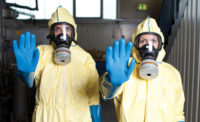Companies spend about $40 billion annually inspecting plants and equipment within the oil and gas, transportation and power generation sectors, and some individual businesses spend $100 million annually, according to General Electric Co., which in June began testing autonomous drones and robotic crawlers to inspect facilities and infrastructure in a number of sectors.
In trials with customers, aerial drones and robots move around and inside remote or dangerous facilities, photographing corrosion or taking temperature, vibration or gas readings. Drone data can be analyzed by computer algorithms and artificial intelligence, Alex Tepper, head of business development at Avitas Systems, a startup GE formed for this business, told the Reuters news service.
Using AI to inspect
GE’s venture is not the first to arm robotic drones with artificial intelligence to inspect dangerous and sometimes hard to access industrial facilities or processes such as refineries and power plants. IBM Corp has been working on systems connected to its Watson artificial intelligence capability for about a year and launched some projects in March, according to the company.
IBM tests include coupling cameras to Watson so they can recognize defects in electronic components whizzing through assembly lines in China and Taiwan. Other IBM projects involve acoustic sensors, or developing Watson-enabled drones to spot frayed power lines on remote electrical towers. IBM and partner ABB Ltd, a Swedish-Swiss conglomerate, combine visual inspection with ABB robots.
"This is one of the hottest areas within IoT (Internet of Things) manufacturing," Bret Greenstein, vice president of IBM Watson internet of things, told Reuters.
Eliminating risky routines
Routine inspections at oil and gas facilities can be time-consuming, costly -- and dangerous. For instance, flare stacks at petroleum refineries can be heated in the hundreds of degrees, and have to cool before inspectors can begin a risky climb to check them out. Workers typically collect inspection data by hand, and the results can take weeks to be analyzed.
That was then, this is the future: GE engineers are designing a cloud-based platform, hosted on the company’s Predix software, that can analyze data from sensors housed in autonomous and semi-autonomous flying and crawling drones.
For predictive analytical revelations, GE’s system combines inspection data with maintenance and regulatory requirements, and also external data sources such as weather. The goal is to make inspections more efficient and safer in the oil and gas, transportation and energy sectors.
These unmanned aerial drones, equipped with sensors, can go where humans cannot. Inspection drones can handle the extreme heat and use infrared cameras and chemical and other sensing technologies to inspect assets in dangerous operating conditions and keep production running. Sensors feed the data to the Avitas Systems platform, and predictive analytics recommend optimal inspection and maintenance schedules, and track changes over time through subsequent inspections.
Algorithms pick inspection times
The technology will help industry move away from rigid inspection schedules based on regulations, and focus on the actual health of the asset. Algorithms can pick the best time for inspections based on signs of corrosion, methane leaks and other often hidden defects to help determine the degree of risk that equipment or processes will fail.
Developers are discovering new methods to analyze data and remotely identify even microfractures. Data from different sites and assets can be collected and analyzed so the system can learn and recognize new patterns. Results end up in human hands to make expert judgments and decsions. GE says robots will not replace humans, but will expand their reach and lower costs.




